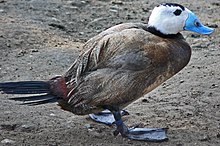Stiff-tail
| Stiff-tailed duck Temporal range: Early Miocene to present |
|
|---|---|
 |
|
| Male white-headed duck, Oxyura leucocephala | |
| Scientific classification | |
| Kingdom: | Animalia |
| Phylum: | Chordata |
| Class: | Aves |
| Order: | Anseriformes |
| Family: | Anatidae |
| Subfamily: | Oxyurinae |
| Genus: |
Oxyura Bonaparte, 1828 |
| Species | |
|
Oxyura australis |
|
 |
|
|
Key:
Range of Oxyura vittata.
Range of Oxyura jamaicensis.
Range of Oxyura maccoa.
Range of Oxyura leucocephala.
Range of Oxyura australis.
|
|
Oxyura australis
Oxyura jamaicensis
Oxyura leucocephala
Oxyura maccoa
Oxyura vittata
The stiff-tailed ducks, Oxyura, are part of the Oxyurinae subfamily of ducks. The genus name is derived from Ancient Greek oxus, "sharp", and oura, "tail".
All have, as their name implies, long, stiff tail feathers, which are erected when the bird is resting. All have relatively large, swollen bills. These are freshwater diving ducks. Their legs are set far back, which makes them awkward on land, so they rarely leave the water.
Their unusual displays involve drumming noises from inflatable throat sacs, head throwing, and erecting short crests. Plumage sequences are complicated, and aging difficult. Plumage is vital for survival because of this animals tendency to spend time in the water.
The six extant members of this genus in summation are distributed widely throughout North America, South America, Australia, Asia, and much of Africa.
A fossil species from the Late Pliocene or of Jalisco (Mexico) was described as Oxyura zapatanima. It resembled a small ruddy duck or, even more, an Argentine blue-bill. A larger Middle fossil form from the southwestern United States was described as Oxyura bessomi; it was probably quite close to the ruddy duck.
"Oxura" doksana from the Early Miocene of Dolnice (Czech Republic) cannot be assigned to any anatine subfamily with certainty.
...
Wikipedia
